Page 83 of 219
Re: Padfield
Posted: Sun Jun 08, 2014 11:44 am
by Goldie M
Great images Guy but I like the one with your the dog best

Goldie

Re: Padfield
Posted: Sun Jun 08, 2014 2:13 pm
by Willrow
Wonderful images, as is usually the case...and it looks as if you've got yourself a new 'buddyflying' companion Guy

you just could'nt ask for much more!!!
Bill
 "When in doubt...venture out"
"When in doubt...venture out"
Re: Padfield
Posted: Sun Jun 08, 2014 2:14 pm
by Padfield
Glad you had a chuckle, Jack! Dogs can be comically intent, even when they have no idea what they're looking at. And thank you for your comments too, Goldie and Bill.
I noted last night that Hostilian was on the point of pupation but that if he decided to wander he would have no chance of finding another sallow. Well, he did wander, and he didn't find a sallow. Between last night and this afternoon he guzzled half of his resting leaf then climbed onto an overhanging sycamore branch that has grown into his sallow sapling during the last month. From there, he travelled between two and three metres in the sycamore and when I found him this afternoon he was on the underside of a sycamore leaf, presumably thinking about pupation. In feeding mode, iris cats never hang around on the undersides of leaves.
You can see a few sallow leaves in the bottom left hand corner of this picture - that is the sapling where Hostilian spent his entire life until last night:
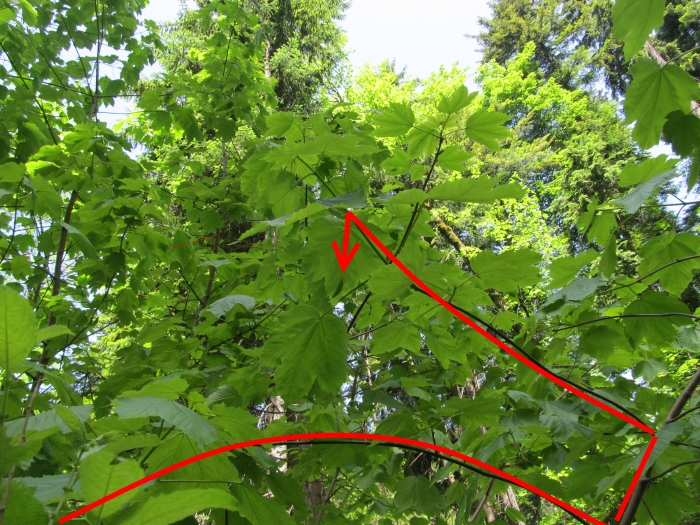
Here he is, now on the underside of the sycamore leaf. I didn't approach closely, as this is a sensitive time and I didn't want to disturb him:


When I first found him he was stationary. I returned about half an hour later and he was quite active, before falling still again. Here are a couple of very jerky (because of the zoom) 30 second videos:
https://www.youtube.com/watch?v=8DccXcRwihw[/video]
https://www.youtube.com/watch?v=ICpDpRfbM8c[/video]
It will be very interesting to see where he has got to tomorrow ...
Returning home, Minnie and I were in for an even bigger surprise. About 200m from the house, a huge butterfly swooped past - a butterfly I can now recognise at several hundred metres, having devoted most of last autumn to it - a female cardinal. I have to say, there is something about cardinals and me. In 2005 I saw and photographed the first individual officially recorded in Switzerland since 1947; last year I discovered the first ever breeding population in Switzerland; today I photographed (rather badly, but who cares!!) the first cardinal for the Canton de Vaud for over 100 years (historically, there are only three records for Vaud, in 1897 and 1899 and 1905). Here she is:

She was highly mobile and I was lucky to get that shot, especially with Minnie in tow. I returned shortly afterwards without Minnie but she was nowhere to be seen.
Lafranchis has noted that in Greece cardinals emerge in spring and then engage in vertical migration to spend the summer in lusher, higher pastures, before returning to the lowlands in late summer to lay - this is a very long-lived species. Others have conjectured a summer diapause (it is known that the females put ovulation on hold during the hot months) and still others have suggested the species is double-brooded in parts of Europe (for which there seems to be no evidence). Today's observation is either evidence of this vertical migration or of dispersion, assuming she is from the population I discovered in the Valley. Whatever - she was a very special sighting!
Guy
Re: Padfield
Posted: Sun Jun 08, 2014 3:19 pm
by Pete Eeles
Great observations, Guy! I think that's the first time I've ever heard of iris pupating anywhere other than on a sallow, and this might go some way to explaining why the pupae are so hard to find! And congrats on the Cardinal!
Cheers,
- Pete
Re: Padfield
Posted: Sun Jun 08, 2014 9:34 pm
by David M
I really don't know how you are able to track these larvae, Guy. You have an exceptional eye, that's all I can say.
Well done with the latest instalment of your 'Cardinal Blog'. I'd love to see this butterfly. It sounds like a super-heavyweight.
Re: Padfield
Posted: Mon Jun 09, 2014 1:14 pm
by Padfield
Thanks, Pete and David.
I'm happy to report Hostilian is definitely pupating there, on that sycamore leaf. These pictures are a little artificial as I had to use flash - I was looking straight through the leaf into the bright sky:



Since he settled on that spot, yesterday, the leaves had moved and in fact, when I arrived, he was poised right next to the stem of another leaf:

The effect would be that every time the wind blew his leaf around he would be walloped against this stem, so I took the liberty of removing it.
Sextus is now in 5th instar:

I have searched in vain for the white admiral caterpillars or their pupae these last couple of days.
Guy
Re: Padfield
Posted: Mon Jun 09, 2014 4:55 pm
by Padfield
A couple more pictures from this evening, when we went to check on Hostilian.
He is visibly transforming, acquiring some of the characters - like the visible segmentation - of the pupa:
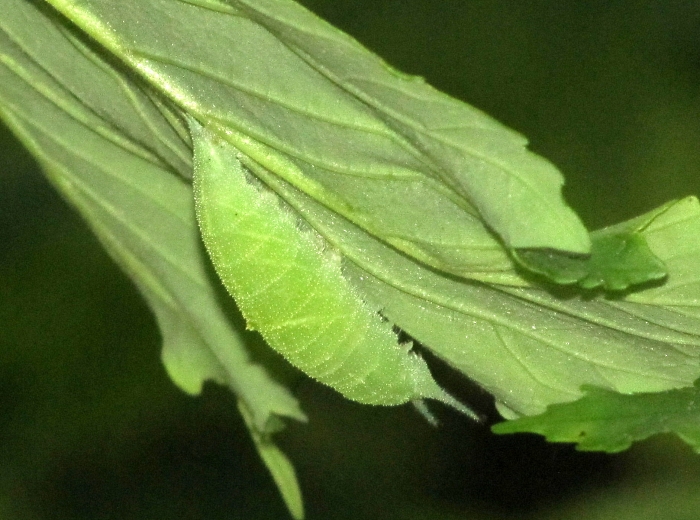
In that picture the leaf looks wilted and crumply but that's only because it's viewed edge on - it is still open and healthy. Hostilian is not at all conspicuous at the moment:
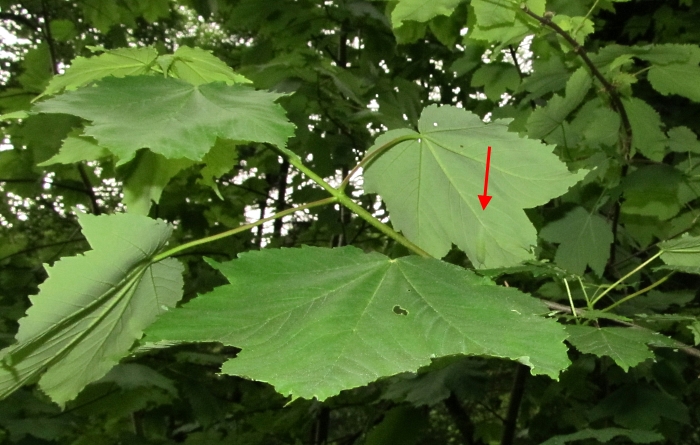
In a day or two there should be a shiny new pupa there. An alpine storm broke while we were there so we ran home, leaving him to the thunder and lightning. If I were him, I wouldn't make any life-changing moves tonight.
Guy
Re: Padfield
Posted: Mon Jun 09, 2014 5:26 pm
by Pauline
Re: Padfield
Posted: Tue Jun 10, 2014 7:04 am
by Padfield
I'll see what I can do, Pauline! I checked every single leaf and twig of the honeysuckles where those two were and they are not on them. Almost certainly, they moved off to pupate on something else, as it must be considered unlikely that both would be eaten just when they're about to pupate.
Hostilian ignored my advice and made his life-changing move last night. This morning ...
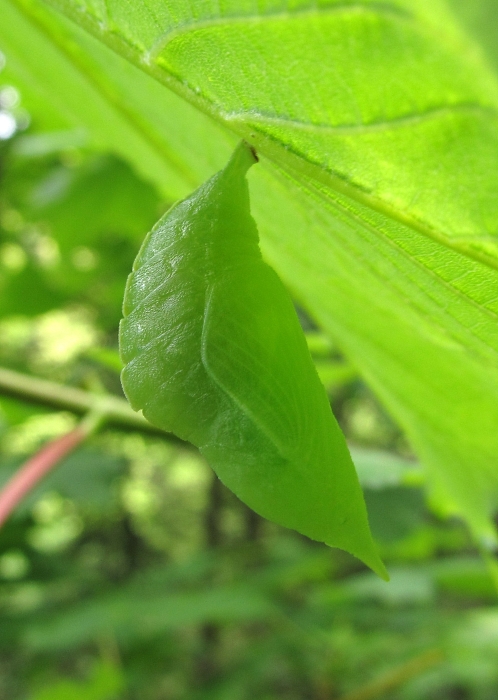
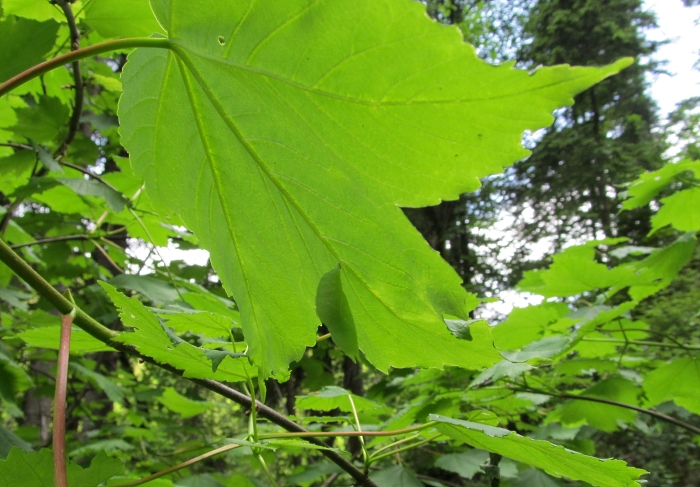
Young, growing sycamore seems to be highly phototropic and the leaves are in a completely different position and orientation every time I see them. His leaf no longer brushes against the stems of any others during the movement (I think).
Guy
Re: Padfield
Posted: Tue Jun 10, 2014 9:44 am
by Jack Harrison
These really are superb observations Guy. If there were more people with your patience and observational skills, there wouldn't need to be a debate about "captive breeding". Sadly though, more mortals don't have your degree of dedication.
Jack
Re: Padfield
Posted: Tue Jun 10, 2014 3:34 pm
by Padfield
Thank you again for your appreciation, Jack! I really do value your comments. You're right, of course, that globally speaking, very few people have the time, will or skills to indulge in monitoring the intimate and secret lives of wild caterpillars. That said, there is a disproportionately high number of such people in the UK Butterflies community, many of whom have been doing it a lot longer than I (like yourself). I won't name names, for fear of slighting by omission, but within these forum pages there are countless observations and insights you won't find in any books. I'm glad to be part of it!
Guy
Re: Padfield
Posted: Fri Jun 13, 2014 5:56 pm
by Padfield
I've been unusually quiet recently, mostly because I was preparing for my final interview with the Commune for acquiring Swiss nationality. In principle, this is an oral exam on all things Swiss. They sent out a booklet on Swiss and local history, geography, culture and civic structure, which I learnt off by heart (something I'm still very good at), but in the event we mostly discussed butterflies and dog-training and I'm very proud to say they welcomed me - so the last hurdle to becoming Swiss has been jumped. Now there is just the indeterminate wait while the wheels of administration turn.
Today's target was poplar admiral, for which we travelled to the canton of Geneva. A friend had seen several males last week so I set off with high expectations. However, this is one of the most short-lived species (average lifespan 8 days) and I saw no males today. I was rewarded with two females, the first of which touched down ever so briefly and allowed a poor photo:

The second female didn't stop at all. This was, however, the first time I have ever set out to see poplar admiral and seen it! All my other sightings have been completely at random when I was looking for something else.
If the poplar admirals put on a rather subdued show, the white admirals were in spectacular form. They were flying literally in their thousands - perhaps tens of thousands. This video clip is not a special highlight - they were like this throughout the four hours I spent wandering the forest looking for
populi (Minnie is on a flexi-lead attached to my belt, as this is a nature reserve).
https://www.youtube.com/watch?v=xKq0GNbpdwc[/video]
Here are some more shots of white admirals:


(Note the woodland brown,
Lopinga achine, tucked in with that lot)

(Minnie encountered for the first time that great wonder of the dog world, the poo-poo that flies away when you sniff it!)




But I couldn't find a single aberration among them!
Woodland browns were common but very difficult to photograph, not because of their natural shyness but because of the white admirals, that would swoop and dive around me even when I was trying to photograph something else. These were the best I could do:


Other new species for the year were ilex hairstreak and silver-washed fritillary. I also saw a single lesser purple emperor but unfortunately we put it up as it was lurking rather discreetly in the shadows and we were looking for poplar admirals - so no photo.
Guy
Re: Padfield
Posted: Fri Jun 13, 2014 6:07 pm
by Pauline
Some fabulous photos there Guy of the White Admirals but I have to say I just love the Minnie shot. Your thoughts on the WA pupa have been helpful. If the larva were not predated then presumably they must have wandered off but that begs the question, how far do they travel and do they have a favourite plant? Surely someone, somewhere must have found one of these pupa in the wild? I am determined to find one in the wild however long the search might take. Next year I shall be more vigilant!
Re: Padfield
Posted: Fri Jun 13, 2014 6:40 pm
by Katrina
Astonishing numbers of WAs and great photography getting so many in focus at once.


Also hooray for Hostilian making it through to pupation!
Re: Padfield
Posted: Fri Jun 13, 2014 6:49 pm
by Mark Tutton
Hi Guy, congratulation on passing your interview - I think you sidetracked them

The white admirals are astonishing - have you ever encountered them in such quantities previously? Fantastic piece of video too - and the shot of Minnie giving them her own scrutiny is lovely.
Kind Regards
Mark
Re: Padfield
Posted: Fri Jun 13, 2014 7:01 pm
by William
Mind Blowing stuff Guy - there were shouts of awe back here in England when I watched that video

BWs
William
Re: Padfield
Posted: Fri Jun 13, 2014 7:56 pm
by Pete Eeles
Congrats on the interview

And those
camilla shots are simply amazing - I've never seen anything like that anywhere on the web! Is there any honeysuckle left in the woodland?
Cheers,
- Pete
Re: Padfield
Posted: Fri Jun 13, 2014 9:50 pm
by David M
Absolutely staggering stuff, Guy. I guess the only time when you could expect similar scenes in the UK would be during a long drought, such as in 1976.
This is one of the reasons I love holidaying abroad to observe butterflies - you see behaviour that you almost certainly wouldn't witness in Blighty.
So glad you seem to have surmounted the (almost) final obstacle to Swiss citizenship. I only wish our own authorities could be similarly stringent.

Re: Padfield
Posted: Fri Jun 13, 2014 10:32 pm
by Neil Hulme
Hi Guy,
That is truly amazing footage of the White Admiral. Incredibly, this sort of abundance is not unheard of in the UK. It is easy, given human lifespan, to soon forget the magnitude of what we have lost.
To quote from Colin Pratt's definitive work 'A Complete History of the Butterflies and Moths of Sussex': "The year of 1919 stands out as the best ever for the White Admiral in Sussex ...... at Abbot's Wood the butterfly flew 'in profusion ... (they were) resting on the path so thickly in some places that it was difficult to walk there without treading on them' (Adkin, 1920a)."
BWs, Neil
Re: Padfield
Posted: Sat Jun 14, 2014 7:20 am
by Padfield
Thank you for your comments, Pauline, Katrina, Mark, William, Pete, David and Neil!! Yes, it was quite a phenomenon. I know those woods are always good for white admirals but I've never witnessed anything quite like yesterday before. Given the number of imagos, there should obviously have been thousands of empty chrysalids all around me - unfortunately, I only did a few brief searches, as I was committed to finding
populi. Amazingly, Pete, there was still plenty of honeysuckle around! Very interesting about 1919, Neil. It really was like that yesterday - you had to look where you put your feet down. Unsurprisingly, there were dead white admirals and white admiral wings scattered like petals, where vehicles, bikes and perhaps even horses and people had carelessly trampled the winged flowers (or winged excrement, as Minnie preferred to see it):

Guy
 Goldie
Goldie 























